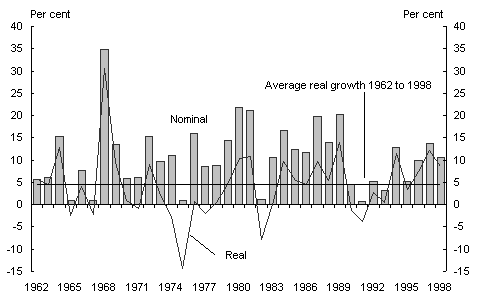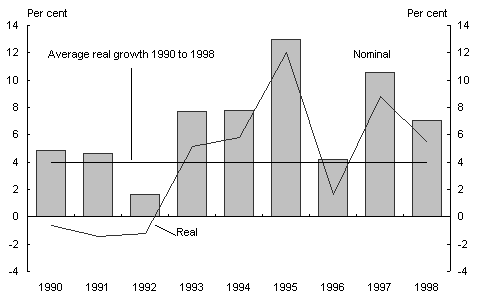The pure economic definition of saving is the change in the wealth or net worth of households from one period to the next. In this context, an important limitation of conventional measures of saving is that they do not take into account the effect of changing asset values on the wealth of households.
There have been several attempts to estimate Australian net private sector wealth. Treasury has published annual estimates of Australian net private sector wealth since the Summer 1990 issue of the Economic Roundup. These estimates relate to financial and physical wealth only and do not make any attempt to value natural resources or human capital. Chart 12 shows annual economic saving of the private sector as measured by the annual growth in real and nominal private net wealth (at market value) over the period since the early 1960s. The growth in real wealth has been volatile over time, particularly through the 1970s and 1980s, where high inflation appears to have had a significant impact. In the 1990s, growth in real wealth has generally exceeded its long run average with lower volatility than previous decades due to lower inflation. Although the rate of growth of both nominal and real wealth was slower through the year to June 1998 than in the previous year, real wealth continued to grow faster than its long run average.
Chart 12: Growth in Australian net private sector wealth at market value(a)

(a) As at June 30.
Source: Treasury update of estimates in the Summer 1999 Economic Roundup.
With the publication by the ABS of the National Balance Sheet it is also possible to obtain a measure of net household saving based on the change in net worth from 1989-90 to 1997-98. The National Balance Sheet values some assets (produced assets) on a replacement cost basis and other assets on a market value basis, whereas the Treasury wealth measure estimates the value of all assets on a market value basis. This is the principal difference between the ABS and Treasury wealth measures. Although the ABS measure includes some asset categories not included in the Treasury measure, neither of the measures attempts to value human capital. Chart 13 shows the annual growth in real and nominal private wealth of households under the ABS measure. As with the Treasury measure, real net wealth has grown strongly through most of the 1990s. However, the relatively short history of this series cautions against reading too much into these data in relation to longer term trends.
Chart 13: Growth in private net worth

Source: ABS Cat. No. 5241.0.
In summary, the Treasury and ABS measures of net private sector wealth suggest that the real net worth of Australian households has grown strongly in the 1990s. As net wealth measures include the full effects of asset revaluations (both appreciation and depreciation), they are not directly comparable in level terms to the private saving measures in Charts 8 and 12. Nevertheless, net wealth measures are consistent with the view that private saving (whether measured on a gross or net basis) has shown only a mild downward trend, if any, over recent decades.
Conclusion
The significant decline in the ABS net household saving ratio since the mid-1970s appears to reflect limitations in the measurement and classification of this measure rather than a significant change in saving behaviour.
Broader measures of the saving behaviour of Australian households, such as gross and net private saving (particularly after adjustment for inflation) and changes in net worth, present a much different picture. While there are uncertainties about the appropriate definition and measurement of saving, these broader measures of private saving have shown a much less pronounced downward trend than the ABS net household saving ratio.
References
Access Economics 1992, The ANZ Saving Measure: a new quarterly measure of Australias saving performance, Canberra.
Anstie, R.K., Gray, M.R. and Pagan, A.R. 1982, Inflation and the consumption ratio, in Pagan, A.R. and Trivedi, P.K. (eds), The effects of inflation, Centre for Economic Policy Research, Australian National University, Canberra.
Australian Bureau of Statistics, Australian System of National Accounts, Catalogue Number 5204.0
, National Income, Expenditure and Product, Catalogue Number 5206.0.
, National Balance Sheet, Catalogue Number 5241.0.
, Upgraded Australian National Accounts, Catalogue Number 5253.0.
, Australian National Accounts Concepts, Sources and Methods, Catalogue Number 5216.0.
Australian Taxation Office, 1986-87 to 1996-97, Taxation Statistics.
Bartley, S. and Phipps, S. 1995, Inflation adjustment of private and public saving and the current account deficit, a paper presented at the 24th Conference of Economists, Economic Society of Australia, Adelaide, September.
Bladen-Hovell, R.C. and Richards, G.M. 1983, Inflation and Australian Savings Behaviour, 1959-1981, Australian Economic Papers, vol. 22, pp. 290-301.
Carroll, C.D. 1991 Buffer Stock Saving and the Permanent Income Hypothesis, Board of Governors of the Federal Reserve System, mimeo.
Covick, O. and Higgs, B. 1995, Will the Australian governments superannuation initiatives increase national saving?, a paper presented at the 24th Conference of Economists, Economic Society of Australia, Adelaide, September.
Dardanoni, V. 1991, Precautionary savings under income uncertainty: a cross-sectional analysis, Applied Economics 23, pp. 153-160.
Dean, A, et al 1989, Saving Trends and Behaviour in OECD Countries, OECD Paris, Working Paper no. 67.
Depta, P., Ravalli, F., and Harding, D., Extended Measures of Investment and Saving, Treasury Research paper No. 8. Commonwealth Treasury, Canberra.
Edey, M. and Britten-Jones, M. 1990, Saving and Investment, in Grenville, S. (ed) The Australian Macroeconomy in the 1980s, 20-21 June, Reserve Bank of Australia, pp. 79-158.
Eisner, R., 1988, Extended Accounts for National Income and Product, Journal of Economic Literature, Vol. 26, pp. 1611-1684.
FitzGerald, V.W. 1993, National savings: a report to the Treasurer, AGPS, Canberra.
Flynn, B. 1993, Aggregate saving in Australia: measurement and trends, Treasury Research Paper, no. 7, Commonwealth Treasury, Canberra.
Gregory, R.G., 1989, The Current Account and Australian Economic Policy under the Labor Government, paper prepared for the 18th Pacific Trade and Development Conference, December 11-14, Kuala Lumpur, Malaysia.
McKissack, A. and Sedgley, P. 1993, The Effectiveness of Personal Savings in Australia, paper presented to the Conference of Economists, 27-30 September 1993.
Makin, T. 1990, The real federal budget imbalance, University of Queensland Discussion Paper in Economics, no. 24.
1990, Inflation and the external account: Australia in the 1980s, University of Queensland Discussion Paper in Economi
cs, no. 35.
1995, Inflation distortion of the external accounts: the Australian example, Journal of Economic Studies, vol. 22 no. 1, pp. 58-66.
Masson, P.R., Bayoumi, T. and Samiei, H. 1995, Saving behaviour in industrial and developing countries, in International Monetary Fund, Staff Studies for the World Economic Outlook, World Economic and Financial Surveys, Washington.
Nevile, J. 1993, Structural deficits and fiscal policy, in Maxwell, P. and Hopkins, S. (ed), Macroeconomics, contemporary Australian readings, Harper, Pymble, NSW.
OMara, L.P. and Walshaw, T.J. 1992, Some implications of inflation adjustment of interest payments on Australias foreign debt, Economic Analysis and Policy, vol. 22, no. 1, March, pp. 51-65.
OECD 1994, Taxation and Household Saving, OECD, Paris.
Treasury, 1999, Australian Net Private Wealth, Summer, Economic RoundUp, pp. 71-81.
22 The higher level of fluctuations in net wealth measures reflects the inclusion of asset revaluations